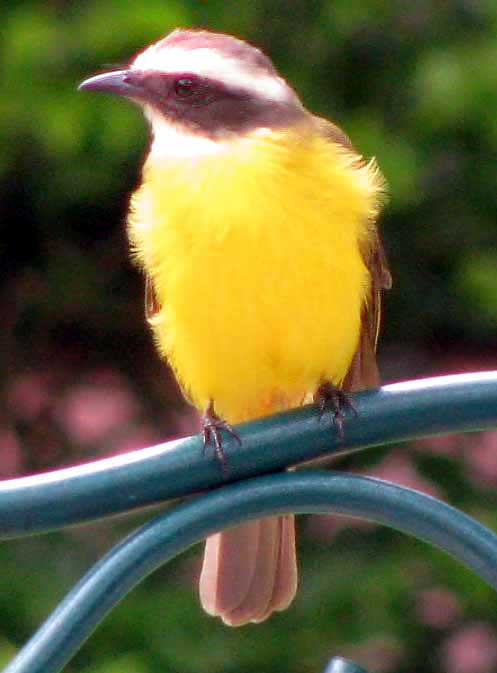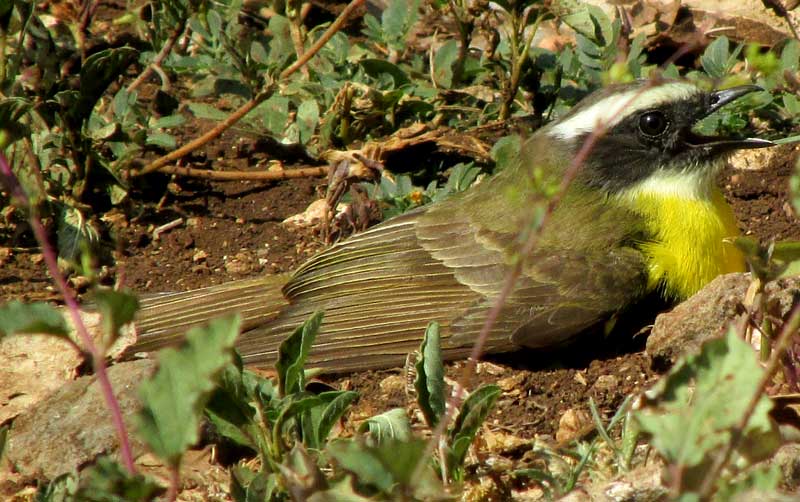Excerpts from Jim Conrad's
Naturalist Newsletter
from the November 8, 2009 Newsletter issued from Hacienda Chichen Resort beside Chichén Itzá Ruins, central Yucatán, MÉXICO; limestone bedrock, elevation ~39m (~128ft), ~N20.676°, ~W88.569°
SOCIAL FLYCATCHERS UP CLOSE
In tourist places sometimes organisms that are hard to see out in the wild show up as if they want to display themselves. That was the case when I took my welcome meal in the Hacienda's open-air dining area, and a Social Flycatcher, MYIOZETETES SIMILIS, flew down onto the top of a chair at the table opposite me. You can see that bird staring back at me below:

A backside view of the same bird is shown below:

Social Flycatchers are pretty common throughout humid, lowland Mexico, and all the way south to Peru and Argentina, but normally you see them in small flocks high in trees, always calling their shrill, monotonous t-cheer-cheer chee-tiquee, as Howell describes it. But here they seem to be curious about humans, and tend to flock with us.
Not only did I get a good close-up look at some Social Flycatchers, but also I got to see one do something special. A Chit fan-palm, Thrinax radiata, grew next to the dining area and was bearing a handsome cluster of white, marble-size fruits. A Social Flycatcher flew into the cluster, took a Chit fruit into its beak, and swallowed it whole. I've never seen any kind of flycatcher swallow anything like a palm fruit, but last Thursday it happened not six feet from where I was sitting.
Two other flycatcher species are very similar to this one, but they're larger and their bills are relatively longer. The other two species are the Great Kiskadee and Boat-billed Flycatcher, both found here. It's hard to judge sizes in the field, but the Social Flycatcher's sociality and that unending, nervous calling is all you need to separate them from the other species, which are more likely to be seen alone, and making very different calls.
from the May 8, 2016 Newsletter issued from Hacienda Chichen Resort beside Chichén Itzá Ruins, central Yucatán, MÉXICO; limestone bedrock, elevation ~39m (~128ft), ~N20.676°, ~W88.569°
DUST-BATHING SOCIAL FLYCATCHER
Earlier this week we had our hottest temperatures of the year, mid-afternoon temperatures of over 100° F (38°C) at the Hacienda 106 and more in Mérida (42°C). One afternoon during the hottest part of the day a Social Flycatcher whirred to a dusty spot on the ground, beat his wings against the dust while stomping and scratching with his feet, and fluttered about until plenty of dust must have penetrated beneath his wings and settled over his body. Then he just sat on the ground, his wings spread from his body and his beak open, as shown below:

I assume that the dust and heat caused some body parasites to abandon ship during this slow cooking process, and I assume that it wasn't comfortable to the flycatcher. Birds don't sweat, so to cool off they can open their beaks so that evaporation from their moist mouths, throats and lungs cools them a little.
Above I mention that the bird "whirred" to the dusty spot. I'm referring to how Social Flycatchers make brief whirring sounds, apparently with their feathers -- somewhat like a turkey's low-frequency, long-carrying feather-drumming. Social Flycatchers make this sound when they rush at other birds or otherwise want to bring attention to themselves. When one wants to drive another bird from the birdbath, he may fly at the bird whirring. However, no other bird was near the hot, dusty spot on the ground when this bird landed there whirring. My impression was that he'd been perching in the Guácimo tree for some time considering whether he should put up with the heat, dust, and my sitting in front of the hut, and then when he decided to take the plunge he did so with self-encouraging, whirring bravado.
After about half a minute the bird shook himself violently, creating a little dust cloud, flew off and began preening.